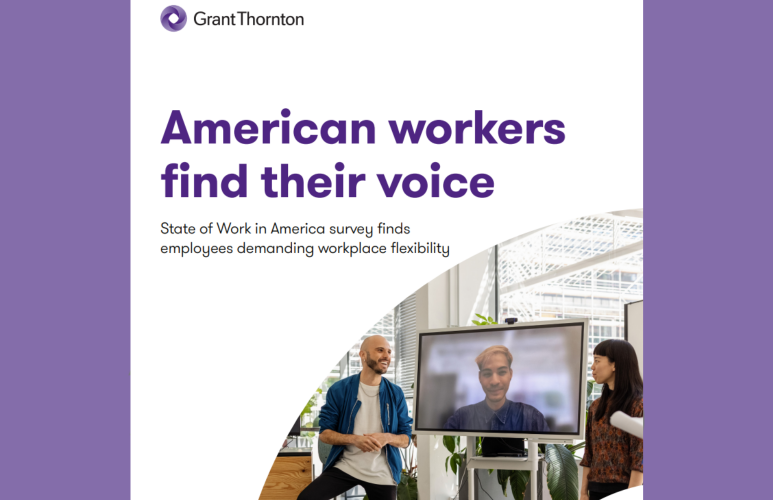You’ve probably suspected this but more than one-quarter (29%) of employees are actively looking for a new job at a different organization. While that figure is down 33% from last year, such a decrease is to be expected since 21% of people switched jobs during the past 12 months.
Those most likely to jump are male millennials who have been with an organization three to nine years who are public-facing.
According to the data in the State of Work in America from Grant Thornton LLP, more than half (51%) of employees are not actively looking for a new job but would consider a switch if the opportunity arose. Among employees who earn an annual salary of $100,000 or more, that figure jumped to 58%.
The survey engaged more than 5,000 full-time employees in the U.S, and its new findings highlight what employees most covet and how organizations can retain their people.
“American workers have found their voice during the pandemic, and they are perhaps keener than ever to ask for what they want — or find it elsewhere,” said Tim Glowa, a principal and leader of Grant Thornton’s employee listening and human capital services offerings.
There’s also evidence that employees are unsure if their employer is taking care of them: 24% of the survey respondents either completely disagreed, disagreed, or slightly disagreed when asked if they’re paid fairly for their contributions to the organization’s success. What’s more, only about half (51%) believe the benefits and rewards they receive are distinctive from what they could receive from another employer.
Some 68.9 million workers left their jobs during 2021, with nearly 70% doing so voluntarily — a one-year record. November and December were particularly volatile, with nearly 10 million workers leaving their jobs at year’s end, according to federal data.
The top reasons workers took a new job were base pay, work-life balance, opportunities for advancement, benefits and greater autonomy. For instance, slightly more than one-third (34%) said their new job offered a better ability to balance work and personal commitments, while 40% said they left their job for a place that offered them a raise of 10% or greater. Within that group, 13% said they received a salary increase of 20% or more.
There’s also evidence that the employees resigning in droves have had options. Almost 60% of the respondents who recently took new jobs had two or more competing offers. When asked why they declined other offers, 42% said base pay did not meet their needs, while 33% said other employers took too long to make an offer. Another 33% said the benefits did not meet their needs, while 27% cited a company’s reputation and 21% said the values of the company they turned down did not align with their personal beliefs.
These reasons, as well as the prevalent desire for more autonomy and greater work-life balance, reveal the value of a workplace tailored to employees’ needs. It’s also apparent that the freedom to work from home has quickly become table stakes, according to Glowa.
The vast majority (80%) of respondents said they want flexibility in when and where they work. Additionally, 25% said they would ideally never work on-site — a 10% jump from Grant Thornton’s survey in 2021. Meanwhile, the percentage of people looking forward to physically returning to an office dipped from 56% to just 38%.
“Flexibility in where you work, and sometimes when you work, is no longer viewed as an extra benefit,” said Angela Nalwa, a managing director and HR Transformation practice leader at Grant Thornton. “In fact, flexibility is now a minimum requirement as job-seekers look for their next career opportunity. The companies who insist on a mandatory return-to-office for all employees must find a differentiator that separates their organization from the pack.”
When asked to rate the three attributes causing the most stress in their lives, 43% of those surveyed cited personal debt as their greatest stressor. The next four most common stressors were, in order, medical issues, mental health, daily inconveniences such as a long to-do list, and work-life balance. In addition to the concerning level of stress tied to mental health, over one-fourth (27%) of employees surveyed said their emotional well-being has worsened in the past 12 months.
There’s a group of people of which 71% are actively looking for a new job — and it’s not the kind of employee most companies may expect These employees are generally positive: They said they have a great manager; they believe their voice is heard at work; and they have a strong work-life balance. According to the State of Work in America survey, these people are also largely millennials (65%), mostly male (also 65%), and 62% of this group have been with their company between three and nine years. Additionally, 82% of this group serve in customer-facing roles, and 60% earn an annual salary of $100,000 or more.
Glowa compares this group to a “sleeping giant” that may foretell a sea change in the ongoing war for talent. In other words, even as resignations slow, employees are still mindful of the power they have. Many are just waiting for the right opportunity.
To see additional findings from Grant Thornton’s latest State of Work in America survey, visit www.gt.com/stateofwork












